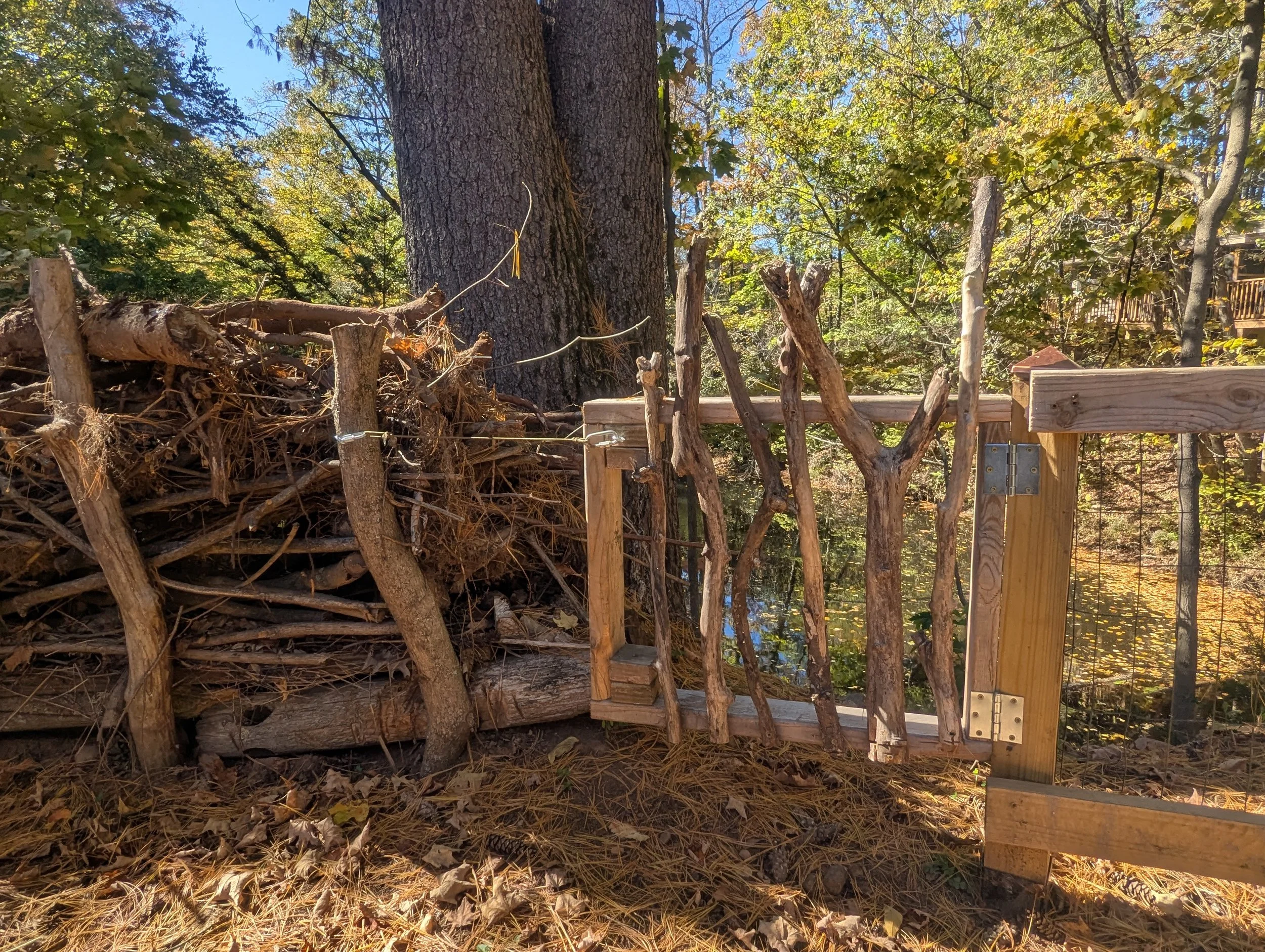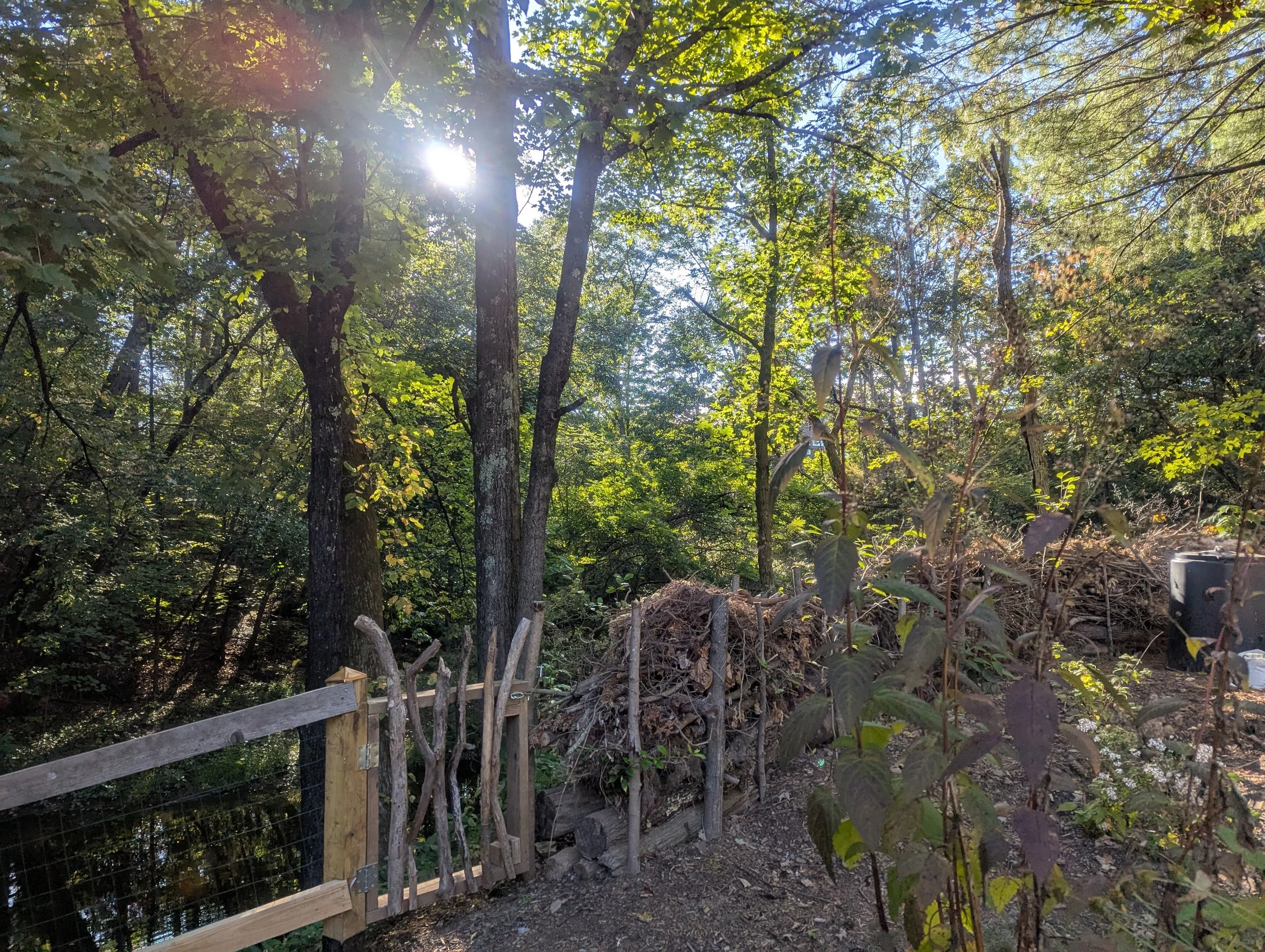Upper Yard Transformation- From invasives + dead lawn to sustainably fenced biodiverse landscape
The upper yard where you first enter The Island is what I would call a classic space that gives folks ‘green blindness’. Meaning- they see green and assume ‘green=good!’. However, upon closer inspection, one would notice that actually every bit of green along that back ridge was actually about 60 mature invasive shrub species- mostly Burning Bush with some Morrow and Japanese Honeysuckle and Kolkwitzia Amablis (commonly called Beauty Bush) that were crowding out any chance of native biodiversity and had very limited ecological benefits for wildlife. It was very overgrown and eating up about an additional 15 feet of footage. The rest of this area was mostly just dead lawn. Full sun sites are at a premium on The Island because of our topography so this south and west facing yard space was not living up to its maximum potential.
I set about removing the invasives in sections over 3 years- staggering removal so as not to leave birds without coverage they were accustomed to while other areas were planted and matured. This included the back of this ledge which is a vertical drop to the water where we could not remove roots due to erosion concerns. I experimented with a method of cut & paint with triclopyr, and then wrapping the stumps in black plastic to suffocate the plant of sunlight.
Burning Bush in particular I have found will resprout cuttings so I am wary of leaving any cuttings in contact with the ground. For this project, I also had the concern of needing to fence the area because it is a ledge that drops to water and we had 4 nephews under 5 en route for a visit. All the old timber fencing around the yard was collapsing and was a major safety issue (see Ruben falling through a rail and off the corner into the water below and me having a heart attack). Because we are on an island with limited space and dragging stuff across the bridges is a lot of labor, I designed a dead hedge as a barrier solution along the back curve which could be built with all the waste material being generated from fence and invasive removals. Thick old fencing and non-invasive timbers were placed on the bottom of this with all invasive growth layered on top to avoid them resprouting. The area will have to be checked each year and have any new invasive seedlings pulled.
The back of the dead hedge was replanted with native shrubs that could be especially useful in erosion control and would handle not being watered with frequency- Rubus Odoratus (flowering rasberry), Rhus Aromatica (low growing sumac that will give the ledge bright color in the fall and be seen from The Cottage), Black Chokecherry, and Bearberry and will be added to overtime. Existing evergreens that are non invasive were left.
Fencing that needed replacing on either side of the deadhedge was built from ripping scrap pile pressure treated lumber to size and using rabbit cage metal netting available from the hardware store. Fences were lofted off the ground enough for the Snapping Turtles to be able to fit under them when they come up on land in the late spring to nest (we’ve seen them literally climb up this rock face ridge- pretty amazing). Gates were made from sycamore branches that look like driftwood to help tie together the organic look of the dead hedge with the contemporary fence lines and still allow access to the ledge for when we need to do maintenance work.
The last issue this space presented was that across the way a commercial neighbor has their security lights at night that create a bunch of light pollution and are an annoyance at night, particularly when the leaves drop. To deal with this issue (in addition to working with them to use covers on their lights) and also the issue of limited storage space on The Island, I sourced a greenhouse second hand and built that in a position to help block those lights at night. I wanted a natural hedge of evergreens- thinking of Eastern Cedars- that could block these out but adding trees on a ledge could potentially cause bigger erosion issues in the future and it will be a few years before they have enough height for me to see any benefit from them. I planted 2 Eastern Cedar saplings that popped up along the driveway as an experiment to see how they do as well as High and Low bush Blueberries and Sweet Fern in this particular corner to live happily in the more acidic conditions of the big Eastern Pine. Several ground nesting bumble bee nests weave in between these plantings so we were careful not to disturb them.
The blue stone walkways in the upper yard were not the worst except that they were narrow and moving large and heavy items in and out over them were not ideal. However, the mixed slate walkways by the front door and leading to the second bridge were a real mess and needed to be redone. Using the remaining second hand bluestone that had been sourced from the patio, we redid these walkway areas to be safer and easier to use. They will be planted with creeping thyme in between pavers to match the enchanted feeling of the patio and soften the lines.
The giant pile of soil from excavating to relay the walkways turned into new garden beds. The great thing about native plants is they’re pretty happy with our native soil. I did add some compost amendment into holes as I planted but some species, once I removed them from places that had richer garden soil and placed them in the unaltered ground, actually suddenly took off- like a buttonbush that had been struggling. These new beds were lined with natural materials- rocks that came out of this soil and large branches and driftwood pieces- to help give them an intentional and polished look. Planted as pollinator and native gardens with species that will enjoy the sun and partial shade, I hate how barren first year beds look but I’m excited to see these fill out and add to them over the next few years.. The back bed has a highbush blueberry hedge that will eventually block the view of a composter that a neighbor was giving away and give us a beautiful autumn palette with bright red and bright orange from the chokecherries behind it.
To enjoy the transformation, click and swipe through.
Before- A still from the video of the first time we ever viewed the property. You can see the dead lawn, large row of invasives, and even the pesticide signs marking the entrance.
After of that same entrance with 1st year plants
Before- winter view of the back wall of invasives where the dead hedge now sits. This year's winter view should be more charming
Before
In progress- after the invasives were removed and the dead hedge built
After- One of my favorite features here, a dead hedge. It will provide a habitat for many birds and small wildlife, looks organic, beautiful and impressive, and gives a sustainable solution for yard waste.
Before
After- right after completion. Walkway will have ground covers planted between pavers so will have soft lines next year. Greenhouse positioned to help block lights from commercial property and feel tucked into the space. New garden beds are to the left of the greenhouse.
Old mill stone was moved from the ground in front of the entrance where it was a pain to move furniture over and stood up to be part of the garden art.
Old Mill Stone- our symbol of the project- planted with native scotch harebells.
Gates designed from downed sycamore branches and driftwood to tie together the organic look of the deadhedge with the contemporary lines of the new fencing. This allows us access for maintenance on the back of the ridge.
Front and back of deadhedge planted with native shrubs.
Before- slate walkways to the front entrance
Before slate and blue stone walkway, completely overgrown with invasives like sheep's sorrel and crab grass. They proved more and more difficult over the years to keep any of this growth suppressed.
Before walkway from front entrance
After- redone walkways with bluestone remnants and new garden beds
After- front entry facing up new walkways
After- 1st year gardens and trellis view out front window
Before- fences were rotted and falling over (and 4 nephews under 5 were en route to our house so childproofing went into high gear with this year's projects)
After- new fencing crafted from scrap lumber ripped to size and rabbit cage wire from hardware store.
Before- Once invasives were cleared, even leaving roots treated with paint and suffocate methods, these ledges were bald and erosion concerned me.
After- Late Figwort to the rescue! In an experiment, I took a figwort branch and sprinkled seeds all down the back bald ledge in question. This year it is covered in seedlings and I think these will do a great job of stabilizing this soil and helping to hold off new invasive growth.






















